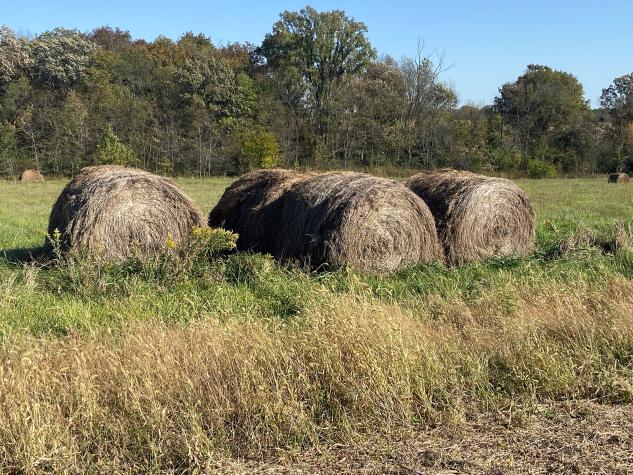Sometimes it's making the 'least worst' decision.
Writer
Eric BaileyCOLUMBIA, Mo. – The recent cold snap increased hay needs for beef cows and is putting the squeeze on tight hay inventory. And without a wet winter to overcome soil moisture deficits, it is possible that grass growth rate will be delayed/slowed this spring.
The University of Missouri recently launched www.feedstufffinder.org, a website to find or list hay and other feedstuffs for sale. Feed pricing is bound to increase if farms are forced back into the market to buy more hay to make it through the winter. Let’s discuss options for farms that run short on hay this winter.
Daily cow feeding
Energy is the most limiting nutrient in beef cow diets in Missouri during the winter. Recently, I observed advertisements for grass hay online for up to $250 per ton. If you can feed commodities, it’s time to take a hard look at them as a hay replacement.
Let’s use corn as an example, as it often sets the price of other commodity feeds. Corn at $5.35 a bushel ($4.60/bushel futures price + $0.75/bushel basis) is $191.07 per ton. Every pound of corn has 80% more energy than 50% TDN (total digestible nutrients) low-quality grass hay. Buying more calories for less money per ton is a wise financial move.
How can I safely substitute corn for hay?
Commodities need to be fed to cows daily if substituting for hay. Start with 5-6 pounds of commodities/cow/day and increase, depending on nutrient requirements. I generally recommend increasing 1 pound per cow per day when working up to greater levels of commodities in a beef cow diet. Fall-calving cows with a calf at side need up to 10 pounds of commodities per day. Corn is a great source of energy but lacks in crude protein; if you are using corn, blend four parts corn with one part dried distillers grains to balance crude protein in the supplement.
The recommendation is not to feed 10 pounds of commodities in addition to free choice hay, but rather to limit feed hay in addition to the daily supplement feeding. Do not feed less than 10 pounds of hay per cow per day, and 15 pounds is a better idea then 10 pounds.
When cow diets become severely limited in hay, the risk of digestive upsets increases when feeding rate and feeding time vary widely day over day. Thus, we must be accurate and consistent with feed calls and feeding time. You do not want to try to keep a cow productive when she cleans up an entire day’s ration in 45 minutes. They will act hungry despite being fed a ration designed to meet or in some cases exceed nutrient requirements.
What do I do if I cannot feed cows daily?
The plan above will not work for farms that currently put out hay once or twice a week. My perception is that farms in this situation are seeking “deals” on forage and building diets around hay.
Bud Williams once said that a farm has three inventories to manage: forage, cattle and cash. Beef cow operations are not cash machines, so we are cautious not to overspend. It’s worth considering weaning fall-born calves early, though, if hay price continues to escalate. Use a value-of-gain calculation to identify what the market is willing to pay you to put additional weight on calves.
Why would we consider weaning calves early? Every 2.5 days that a calf is weaned early saves one day’s feed for a cow. By cutting nutrient requirements by 40%, we reduce the number of bales needed rather than having to go out on the market to procure more hay. This recommendation is challenging for farms with long calving seasons.
Let’s assume that calving started Aug. 15 and ended Nov. 1. There will be 150-day-old calves and 90-day-old calves weighing anywhere from 250 pounds to 375 pounds. I have no concerns weaning a 150-day-old calf, but the 90-day-old calf may be less desirable in the marketplace despite being physically capable of transitioning from a milk-based to a forage-based diet. Perhaps weaning the older calves and marketing them can make a dent in your hay needs.
Let’s examine a value of gain example. I use the Missouri Department of Agriculture’s Weekly Market Summary when doing value-of-gain calculations. In the summary published Jan. 22, 2024, a 321-pound steer calf brought $3.19 per pound, and a 431-pound steer brought $324.87 per pound.
Right off the bat, there is no price slide, and thus the market is willing to pay more than $3.19 per pound for you to put another 100 pounds on these calves. Assuming a calf gains 2 pounds per day from birth to weaning, each day that calf is on your farm, he is generating $6.38 in revenue. If you can feed your cow for less than $6.38, then you are making money. If not, then it makes financial sense to sell the calf.
How about heifers? In the Jan. 22 market summary, a 309-pound heifer brought $2.80 per pound, and a 425-pound heifer brought $2.73 per pound. The market paid you $293.25 to put 116 pound on these heifers, or $2.53 per pound. That makes your budget tighter because a heifer calf is only generating $5.06 every day she is on your farm, again assuming 2 pounds average daily gain from birth to weaning. Use pricing from the market you usually sell calves at to dial value-of-gain calculations in even further.
Regardless of the path you choose, make sure the decisions you make to get cows through the winter make financial sense. Sometimes we have to make the “least worst” decision rather than the best decision.
Originally published by Cattlemen’s News, Joplin Regional Stockyards, Inc. Distributed with permission.
